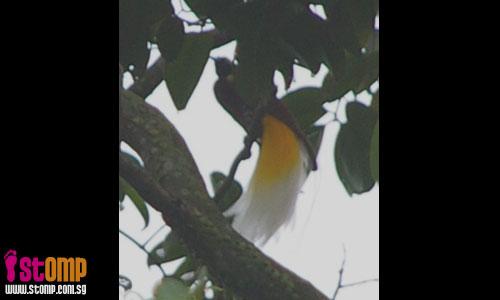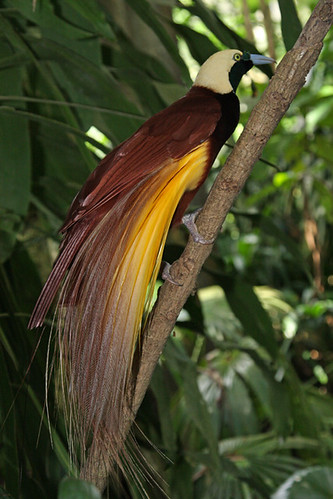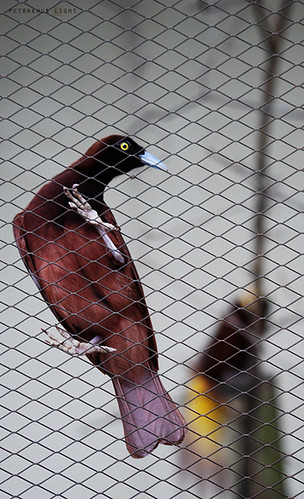
STOMPer Slow saw this gorgeous Greater Bird of Paradise at East Coast Park on Apr 12 and wonders if it is lost. She says:
"Think someone lost their Greater Bird of Paradise.
"Spotted one yesterday (Apr 12) morning at East Coast Park near Bedok Jetty.
"It was calling quite loudly around 7.30a.m."
On Sunday night, Gloria Seow left a message on the wildbirdSingapore Yahoo! Group:
Was at East Coast Park at 730am near Bedok Jetty when we heard a strange call. Upon investigating, we spotted the Greater Bird of Paradise (43cm) w our naked eyes and managed a few shots - see picture. Went back to the car to get the big camera but the bird had already flown into the grove of trees even after waiting around for it for 1/2 hr.
We checked - its a CITES II species - meaning that one requires an export licence but no import licence. Sad that these birds can still be traded legally. Glad that it has escaped!
A bird of paradise? In Singapore? What an unexpected surprise!
This bird was definitely an escapee. I wonder who might be owning and rearing birds of paradise here in Singapore.
The greater bird of paradise (Paradisaea apoda) is a native of the forests of southwest New Guinea and the nearby Aru Islands. Here's a nicer photograph of a male:

(Photo by Bertrand Linet)
Compared to the male with his dazzling array of plumes, the female is much more drably-coloured:

(Photo by petrakhus light)
This species is not considered endangered, and is listed as a species of Least Concern in the IUCN Red List of Threatened Species. A species is thought to be of Least Concern when it has been evaluated against the criteria and does not qualify for Critically Endangered, Endangered, Vulnerable or Near Threatened. Widespread and abundant taxa are included in this category.
However, as mentioned by the person who submitted this post to STOMP, this species is on Appendix II of the Convention on International Trade in Endangered Species of Wild Fauna and Flora. Which means that:
- An export permit or re-export certificate issued by the Management Authority of the State of export or re-export is required.
- An export permit may be issued only if the specimen was legally obtained and if the export will not be detrimental to the survival of the species.
- A re-export certificate may be issued only if the specimen was imported in accordance with the Convention.
- In the case of a live animal or plant, it must be prepared and shipped to minimize any risk of injury, damage to health or cruel treatment.
- No import permit is needed unless required by national law.
As a signatory to CITES, Singapore has in place laws to regulate the trade in endangered species. According to the legislation, on top of the above criteria listed by CITES, an import permit is also necessary before a CITES-listed species can be brought into Singapore. You can find out more by reading all about the Endangered Species (Import and Export) Act.
However, as stated in a reply to Gloria's message:
You're so lucky to see this bird, though not at the right habitat..Yes they are classified as App II of CITES which allows trade with the issuance of permits. However the catch is, Indonesia and PNG does not allow any export of the species. They are protected by domestic law in these range countries. So legal export is impossible, technically.
However over 150 individuals from the genus Paradisaea, Cicinnurus and Seleucidis have been imported here from the Solomon Islands and African countries like Liberia, Guinea and Ivory Coast in 2005. They were all declared as captive bred specimens. How far this is true we do not know. Its hard to imagine a war torn, famine stricken countries in Africa have the means and resources to breed these birds like bantam chickens. But they manage somehow, i guess. Wonders never cease..
So it seems that the legal status of birds of paradise in private collections in Singapore appears to be quite suspicious.
The birds of paradise consist of 40 or so species distributed in New Guinea, eastern Indonesia, northern Australia and surrounding islands. The males of many species are extremely colourful, and they are known for their extravagant displays, as can be seen from the next couple of video clips:
A couple of other exotic birds have made an appearance in Singapore; a toco toucan (Ramphastos toco) was spotted roaming Seletar Hills last October and this January, while there were 4 reports in August and September last year of a grey crowned crane (Balearica regulorum) in the Jalan Kayu area. The Bird Ecology Study Group has noted other exotic species, such as Narcondam hornbill (Rhyticeros narcondami), southern ground hornbill (Bucorvus leadbeateri), palm cockatoo (Probosciger aterrimus), rainbow lorikeet (Trichoglossus haematodus), pin-tailed whydah (Vidua macroura), red avadavat (Amandava amandava), mandarin duck (Aix galericulata) and radjah shelduck (Tadorna radjah). It is most likely that these were escapees or even deliberate releases from captivity.
Quite a number of our non-native birds are present because of the trade in birds as pets. These include many species of parrot, some of which have become established locally, such as the Tanimbar corella (Cacatua goffiniana) and yellow-crested cockatoo (Cacatua sulphurea), red-breasted parakeet (Psittacula alexandri) and rose-ringed parakeet (Psittacula krameri). There are breeding populations of non-native songbirds such as the sooty-headed bulbul (Pycnonotus aurigaster), red-whiskered bulbul (Pycnonotus jocosus), white-crested laughingthrush (Garrulax leucolophus), hwamei (Garrulax canorus) and Japanese white-eye (Zosterops japonicus) in various parts of Singapore. As a hub for the exotic pet trade, both legal and illegal, it is not surprising that so many non-native species are popping up in Singapore. I can understand parrots and songbirds being sold and kept as pets, but it's truly amazing to hear of birds of paradise, hornbills and toucans being reared by private individuals.
Interestingly enough, the Oriental white-eye (Zosterops palpebrosus), a former native that was wiped out before the 1970s, has made a comeback of sorts, thanks to the establishment of a feral population that originated from escapees.
The population of Oriental pied hornbill (Anthracoceros albirostris) seen around the forests and woodlands of the Central Catchment Area, Toa Payoh and Yio Chu Kang are possibly hybrids; among the original founders were a pair of escapees belonging to different subspecies, one belonging to the northern race (Anthracoceros albirostris albirostris) and the other belonging to the southern race (Anthracoceros albirostris convexus). So these hornbills are actually of captive origin, unlike those found in Pulau Ubin and Changi, which are descended from wild birds that flew over from Johor.
The lone female rhinoceros hornbill (Buceros rhinoceros) and its former partner the female great hornbill (Buceros bicornis) that until recently used to fly around the Bukit Timah area are also ex-captives.
While the chances of most of these escapees breeding and establishing populations in Singapore are slim, one cannot discount the possibility that given certain conditions, successful breeding can occur. Escapees and exotic species certainly do add quite a fair bit of variety to our bird lists, but my greatest worry is whether all these introduced species will negatively impact our native birds.